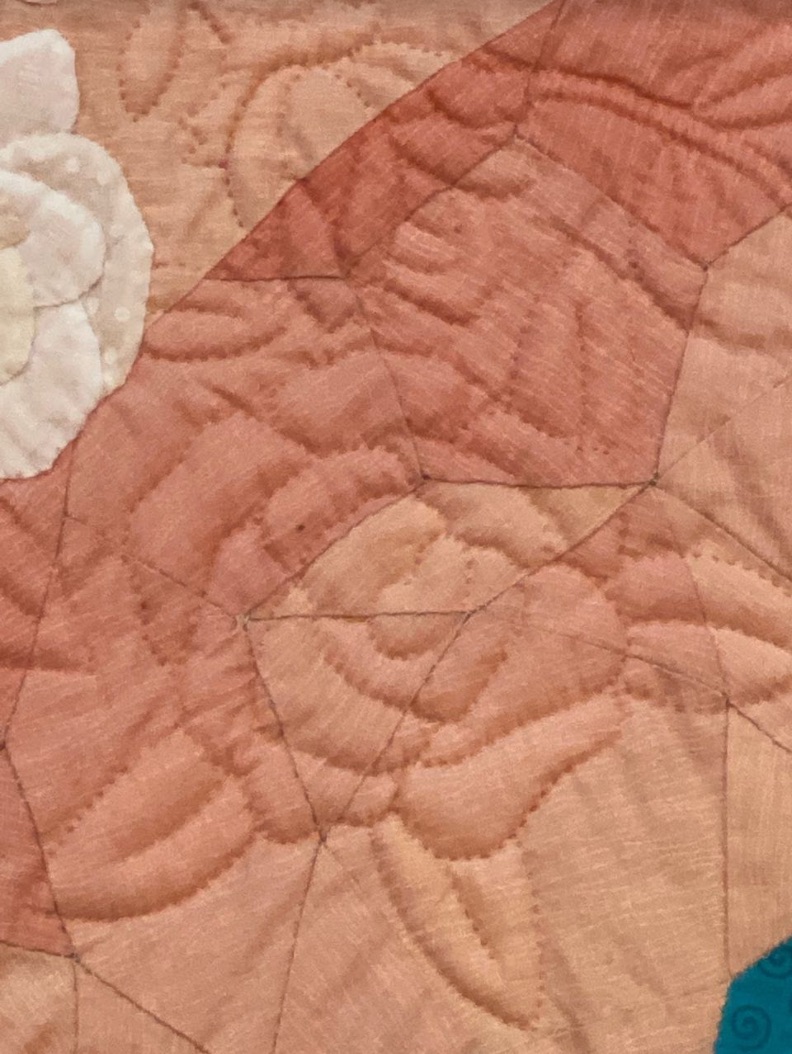 4
4

In this lesson, we continue our focus on Asymmetrical Balance, where the visual arrangement of elements (color, texture, space, etc.) is balanced, but with a more energetic and exciting feeling.
Let's look at the example Bath Balloon Fiesta by Miyuki Humphries. Both the balloons at the top of the quilt, and the Royal Crescent building in the lower portion, use almost the same amount of space. There is a real sense of movement as the building's curve sweeps across from one side to the other. The motion of movement is repeated by the curved balloon floating up and away. This arrangement of two sides that are different (balloons and a building), create a sense of balance and real interest for the viewer.
Asymmetrical balance can be achieved using a number of different methods
- Place objects directly opposite each other in a composition
- Place lighter colors higher than darker colors in a composition
- Emphasize motion to move the eye along across your composition
- Introduce a pop of color
Bath Balloon Fiesta by Miyuki Humphries. (Image by TheQuiltShow.com)
Let's look at some excellent examples featuring these principles:

Weeds Are Flowers Too by Terry Grant (Image courtesy of Terry Grant)

Kaleidoscopic XXXVII: The Artful Non Sequitur by Paula Nadelstern (Show 307, Show 508, Show 2010). [Image byTheQuiltShow.com]

Dandelion by Kate Themel. (Image courtesy of Kate Themel)

Splat! by Dawn Siden. (Image AQS)

Pauline's Ford by Rod Daniel. (Image courtesy of Rod Daniel)
Fiber artist Linda Beach (Show 1409) is known for translating naturescapes into stunning quilted works of art. From sketch to finished work, Linda's works evoke feelings that transport you along her magical journey.

Asymmetrical Balance
by Linda Beach (Show 1409)
(All images courtesy of Linda Beach, unless otherwise noted)
Asymmetrical balance can be defined as when elements on either side of a composition do not reflect one another, as opposed to symmetrical balance where elements on each side of a composition mirror each other or closely match. When you are using asymmetrical balance in a composition, you want to make sure that the visual weight of the work balances even though the actual elements do not mirror each other. While a composition with asymmetrical balance may not be as easy to design as a symmetrical one, it can often be much more visually interesting. Many times something more complex and dynamic is created as a result of the visual tension when asymmetrical balance is used.
So how do you achieve asymmetrical balance? Understanding visual weight is important. Which leads to the next question of what is visual weight? My favorite definition of visual weight is the ability of an area or element of art within a composition to draw attention to itself. Some of the ways to direct a viewers’ attention to an area include the use of color, value contrast, line or shape.

In my piece Marking Time I used asymmetrical balance in the composition because I wanted to convey the feel of the immense open space of the rolling hills or prairie as the setting for an old, abandoned farmhouse. The landscape needed to have a large presence to give that sense of endless space even though my focal point was going to be the farmhouse in the grove of trees. With that in mind, I needed to find a way to make the landscape compelling and interesting but not so that it overwhelmed the farmhouse.
Working within the parameters of my concept of a farmhouse and trees in a landscape, I decided that the house and trees would be of a dark value with the surrounding area in light to medium values. This eliminated the use of value to achieve asymmetrical balance as well as shape or color as I did not want any other objects on my imaginary landscape to distract from the farmhouse and trees. My decision was to use line to achieve the asymmetrical balance. When looking at Marking Time, all the lines or contours of the landscape run between the house and trees in the lower right to the opposite end of the piece in the upper left corner. Your eye, after taking in the focal point of the house and trees, is drawn into the rest of the landscape by following the lines upwards into the hills. The number of running lines and differing shades of yellows and golds create a compositional shape in of itself so that a counterweight is provided and asymmetrical balance is achieved between this area and the farmhouse and trees.


Symmetrical Design Asymmetrical Design
Practice Exercise:
Using a shape of your choice (i.e. circle, square, triangle, hexie), create a symmetrical AND an asymmetrical design based on what you have learned in this and the previous lesson (Lesson 32).
Click here for more topics related to The Art of Quilt Design program.




 Designs can be round or square, including Kaleidoscope images, which are radial. A Radial design can be very effective, as it draws the eye into the center of the design. Examples of Radial balance found in nature and man made objects include:
Designs can be round or square, including Kaleidoscope images, which are radial. A Radial design can be very effective, as it draws the eye into the center of the design. Examples of Radial balance found in nature and man made objects include:



















 Barbara Black will be working on Alex's Mystery Quilt as well and has set up a Forum topic where you can ask questions, post photos, and enjoy the process more with like-minded friends. This is especially helpful for those who don't do Facebook:
Barbara Black will be working on Alex's Mystery Quilt as well and has set up a Forum topic where you can ask questions, post photos, and enjoy the process more with like-minded friends. This is especially helpful for those who don't do Facebook: 











.jpg)


